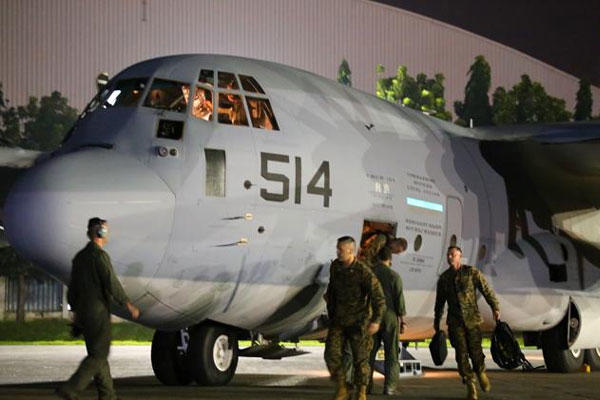The U.S. Defense Department ordered an aircraft carrier and other naval warships to the Philippines as Marines began arriving in the hardest-hit areas to joint relief efforts following a deadly typhoon.
The USS George Washington will leave Hong Kong for the Philippines later Monday evening, as per instruction from Defense Secretary Chuck Hagel, according to Pentagon Press Secretary George Little. The carrier, which holds 5,000 sailors and more than 80 aircraft, will join several other Navy ships and arrive at the country in two to three days, he said in a statement.
"These ships and aircraft will be able to provide humanitarian assistance, supplies, and medical care in support of the ongoing efforts led by the government and military of the Republic of the Philippines," Little said. "The Defense Department is continuing to work closely with the Philippine government to determine what, if any, additional assets may be required."
One of the most powerful storms ever recorded, Typhoon Haiyan struck the eastern part of the country on Nov. 8. The islands were raked with gusts reported in excess of 200 miles per hour. As many as 10,000 people may have been killed in the city of Tacloban alone.
Accompanying the aircraft carrier will be the cruisers USS Antietam and USS Cowpens, and the destroyer USS Mustin. The supply ship USNS Charles Drew is already underway and will rendezvous with the group. The destroyer USS Lassen is also headed to the region.
The Washington houses Carrier Air Wing Five, including MH-60S Seahawk helicopters flown by pilots of Helicopter Sea Combat Squadron 12 and MH-60R Seahawk helicopters operated by the crew of Helicopter Maritime Strike Squadron 77.
Meanwhile, U.S. Marines from Okinawa began arriving in the Philippines on Monday.
"I don't believe there is a single structure that is not destroyed or severely damaged in some way -- every single building, every single house," Marine Brig. Gen. Paul Kennedy, deputy commander of the 3rd Marine Expeditionary Brigade, said after a quick helicopter tour of Tacloban, capital of Leyte province.
On the tarmac at Tacloban airport, where two Marine KC-130J cargo planes were unloading supplies, Kennedy told the Associated Press that Philippine troops were handling security well and the Marines were "looking at how to open up roads and land planes and helicopters."
Kennedy said, "We got shelter coming in" for Tacloban, where bloated and uncollected bodies of the dead lay in the streets and washed up on shore.
About 90 Marines and sailors from the 3rd MEB flew to Tacloban as lead elements in the relief effort aboard the two KC-130s from Marine Aerial Refueler Transport Squadron 152 out of the Futenma Air Station on Okinawa.
The KC-130s were expected to service Marine MV-22 Osprey tilt-rotor aircraft that were also being dispatched from Futenma on the 1,000-mile trip to Tacloban. Two Navy P3-Orion patrol planes were also being sent from the Navy's Seventh Fleet in Japan to aid in search and rescue.
Haiyan's winds were among the strongest ever recorded, and the death toll was expected to surpass that of the previous deadliest Philippine storm, Thelma, in which about 5,100 people died in the central Philippines in 1991. Haiyan has impacted more than 4.2 million people in 36 provinces, officials said.
Two officials said Sunday that Friday's typhoon may have killed 10,000 or more people, but the official death toll stood at less than 1,000, the AP reported. Edwin Lacierda, a spokesman for Philippines President Benigno Aquino, said "we pray" that the death toll is less than 10,000.
Kennedy's initial task was to set up a forward command element (FCE) and a humanitarian assistance survey team (HAST) for follow-on relief efforts, the Marines said.
Aquino's government has asked for surface maritime search and rescue (SAR), airborne maritime SAR, medium-heavy helicopter lift support, fixed-wing lift support and logistics enablers. This includes requests for the Marine Corps' KC-130 planes and MV-22 osprey tilt-rotor aircraft.
Haiyan, known locally as Typhoon Yolanda, hit the Philippines last Friday and its sustained winds weakened to 74 mph as the storm made landfall in northern Vietnam early Monday. Authorities there evacuated hundreds of thousands of people, but there were no initial reports of significant damage or injuries.
Haiyan was downgraded to a tropical storm as it entered southern China later Monday, and weather officials forecast torrential rain in the area until Tuesday.
No major damage was reported in China, but the official Xinhua News Agency said heavy winds tore a cargo ship from its moorings in southern China and drove it out to sea, killing at least two crew members.




























